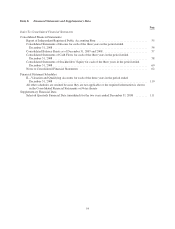Yahoo 2008 Annual Report Download - page 51
Download and view the complete annual report
Please find page 51 of the 2008 Yahoo annual report below. You can navigate through the pages in the report by either clicking on the pages listed below, or by using the keyword search tool below to find specific information within the annual report.repatriated to the U.S. but, under current law, would be subject to U.S. federal income taxes (subject to an
adjustment for foreign tax credits). Currently, we do not anticipate a need to repatriate these funds to our U.S.
operations.
We invest excess cash predominantly in money market funds and marketable debt securities that are liquid,
highly rated, and the majority of which have effective maturities of less than one year. Our marketable debt and
equity securities are classified as available-for-sale and are reported at fair value, with unrealized gains and
losses, net of tax, recorded in accumulated other comprehensive income. Realized gains or losses and declines in
value judged to be other-than-temporary, if any, on available-for-sale securities are reported in other income, net.
The fair value for securities is determined based on quoted market prices of the historical underlying security or
from readily available pricing sources for the identical underlying securities that may not be actively traded as of
the valuation date. As of December 31, 2008, certain of our marketable debt securities had a fair value below cost
due to the changes in market rates of interest and yields on these securities. We evaluate these investments
periodically for possible other-than-temporary impairment and review factors such as the length of time and
extent to which fair value has been below cost basis, the financial condition of the issuer, and our ability and
intent to hold the investment for a period of time which may be sufficient for an anticipated recovery in market
value. We have the intent and ability to hold these securities for a reasonable period of time sufficient for a
forecasted recovery of fair value up to (or beyond) the initial cost of the investment and expect to realize the full
value of all of these investments upon maturity or sale.
We expect to continue to generate positive cash flow from operations for the first quarter of 2009. We use cash
generated by operations as our primary source of liquidity because we believe that internally generated cash
flows are sufficient to support our business operations and capital expenditures. We believe that existing cash,
cash equivalents, and investments in marketable debt securities, together with any cash generated from
operations will be sufficient to meet normal operating requirements including capital expenditures for the next
twelve months. However, we may sell additional equity, or debt securities, or obtain credit facilities to further
enhance our liquidity position, and the sale of additional equity securities could result in dilution to our
stockholders.
See Note 8—“Investments” in the Notes to the consolidated financial statements for additional information.
Cash flow changes
Cash provided by operating activities is driven by our net income, adjusted for non-cash items, and non-operating
gains and losses from sales of investments. Non-cash adjustments include depreciation, amortization of
intangible assets, stock-based compensation expense net of stock-based restructuring expense reversals, non-cash
restructuring charges, goodwill impairment, tax benefits from stock-based awards, and excess tax benefits from
stock-based awards. Cash provided by operating activities was greater than net income in 2008 mainly due to the
net impact of non-cash adjustments to income. In the year ended December 31, 2008, operating cash flows were
positively impacted by changes in working capital balances, including a one-time payment from AT&T Inc. In
each of the three years ended December 31, 2008, 2007, and 2006, cash flows from operations were reduced by
the increase in our accounts receivable balance, mainly reflecting increases in revenues. Additionally, in the
years ended December 31, 2008, 2007, and 2006, there were significant increases in accrued expenses and other
liabilities that positively impacted cash flow from operations. In 2008, these increases were mainly due to higher
accrual balances for restructuring. In 2007, these increases were mainly due to higher accrual balances for taxes
payable. In 2006, these increases were mainly due to TAC payments to Affiliates.
Cash used in investing activities is primarily attributable to capital expenditures, purchases, sales and maturities
of marketable debt securities, purchases of intangible assets, as well as acquisitions including our strategic
investments. Our capital expenditures totaled $675 million, $602 million, and $689 million in 2008, 2007, and
2006, respectively. Our capital expenditures have been primarily used for purchases and internal development of
software to support our offerings and our increased number of users. We invested a net $209 million in
45
























